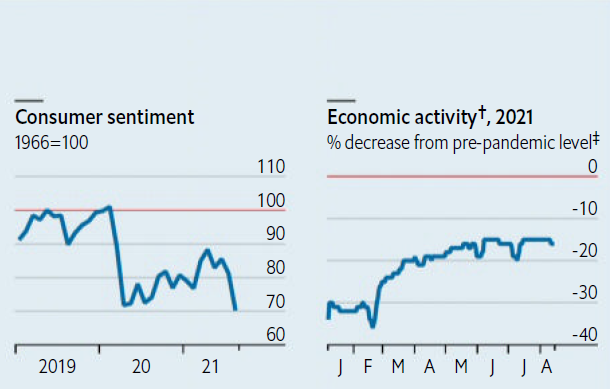Finance & economics
財經板塊
Emerging markets: Feeling the heat
新興市場:壓力來襲
As inflation rises, policymakers in poor countries face a stern test
隨著通脹的上升,貧窮國家的政策制定者面臨著嚴峻的考驗
IT HAS BEEN a long few months for the emerging world.
對于新興世界來說,過去這幾個月尤為漫長。
Punishing temperatures—July was the hottest month on record worldwide, according to a recent analysis—fanned fires on Turkey’s Mediterranean shores and scorched Russia’s wheat fields.
酷熱的氣溫——根據最近的一項分析,7月是全球有記錄以來最熱的一個月——助長了土耳其地中海沿岸的大火,烤焦了俄羅斯的麥田。
Covid-19 rages across countries with low vaccination rates.
新冠肺炎還在疫苗接種率低的國家肆虐。
Just 24% of Brazilians, 9% of Indians and 7% of South Africans are double-jabbed.
只有24%的巴西人、9%的印度人和7%的南非人接種過兩劑疫苗。
On top of everything else, inflation is running hot, too.
除此之外,通貨膨脹也在加劇。
Soaring food and energy prices have pushed inflation to uncomfortably high levels.
不斷飆升的食品和能源價格已將通脹推至令人不安的高位。

In Brazil consumer prices are 9% higher than they were a year ago, more than twice the central bank’s target.
巴西的消費價格比一年前高出9%,是央行目標數字的兩倍多。
In Russia inflation is 6.5%, well above the central bank’s aim of 4%.
俄羅斯的通脹率為6.5%,遠高于央行4%的目標。
Inflation in India, which had been high in 2020, rose above 6% this summer—north of the Reserve Bank’s target range.
印度的通脹率在2020年居高不下,今年夏天升至6%以上,超出了印度央行的目標區間。
Policymakers in poorer countries have navigated a fraught path this year.
今年,較貧窮國家的政策制定者一路走來滿是荊棘。
The outbreak of high prices lays another severe test at their feet.
高油價的爆發給他們帶來了另一個嚴峻的考驗。
Growth has mostly resumed, despite the continued ravages of covid-19.
盡管新冠疫情持續肆虐,但經濟增長已基本恢復。
In parts of the emerging world, such as India, output has already regained its pre-pandemic level.
在印度等部分新興國家,產出已恢復到疫情前的水平。
In others, such as Russia, it is expected to do so by the end of the year.
在俄羅斯等其他國家,預計將在今年年底前實現同樣的目標。
Soaring prices for oil, metals and agricultural products have been a boon for commodity exporters.
石油、金屬和農產品價格不斷飆升,給大宗商品出口國帶來了福音。
But recoveries have been frustratingly uneven.
但經濟復蘇的不平衡性讓人相當沮喪。
Better times for export industries have not always translated into broader labour-market recovery.
出口行業的好轉并不等同于更大范圍的勞動力市場復蘇。
Business is booming in Brazil’s mining towns, for instance, but the unemployment rate across the country, at 14.6%, has scarcely declined from its pandemic peak.
例如,巴西礦業城鎮的商業正在蓬勃發展,但全國14.6%的失業率與疫情高峰期相比幾乎沒有下降。
譯文由可可原創,僅供學習交流使用,未經許可請勿轉載。











